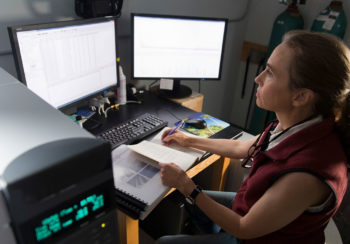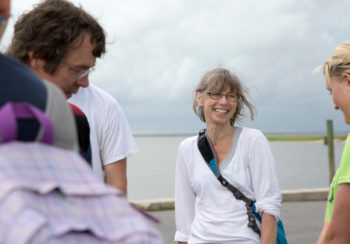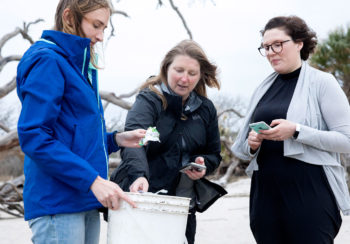Mary Ann Moran, Distinguished Research Professor of Marine Sciences and Regents’ Professor, is a leading expert in ocean microbial life that drives the global carbon cycle. A biologist who arrived at UGA as a doctoral candidate in 1983, she studies how communities of marine microorganisms interact in the ocean, and how those interactions could change in response to a warming climate. She is a fellow of the American Association for the Advancement of Science and received the SEC Faculty Achievement Award in 2018.
Why study ocean microbes?
Microbes, marine or otherwise, are the engines of the elemental cycles that we all depend on. They are crucial for our survival and health. The more we learn about the microbes that inhabit the oceans, the human gut, agriculture systems, and most other habitats on the planet, the better off we will all be.
 Which microbes and processes do you study?
Which microbes and processes do you study?
My work focuses on how microbes move carbon through the ocean. Phytoplankton are single-cell microbes that absorb or “fix” carbon dioxide from the atmosphere using photosynthesis. About half of all the carbon fixed annually on Earth happens right in the surface ocean by these microbes. Some of the carbon phytoplankton fix is excreted into seawater, or when they die, the contents of their cells are left behind. This material is then grabbed by bacteria, even smaller microbes that are very effective scavengers. These interacting microbes can be thought of as a “microbiome,” much like the microbiome of the human gut. My team is looking for the compounds that bacteria are scavenging and the genes they use to do it.
Do some phytoplankton and bacteria only work together?
We are just starting to understand how specific groups of phytoplankton and bacteria have evolved one-on-one interactions. Imagine that a compound released by one specialized group of phytoplankton can be used by only one specialized group of bacteria. Then think of all of the possible compounds and interactions that could have evolved over time, giving these phytoplankton and bacteria unique roles within the ocean microbiome.
How will climate change affect these interactions?
As the oceans warm, it is predicted that there will be a shift to smaller phytoplankton species more efficient at taking up scarce nutrients. My laboratory is learning how much and in what form carbon is released to bacteria by phytoplankton groups that vary in size and physiology. Smaller groups of phytoplankton that are favored in a warmed ocean may have very different interactions with bacteria than their larger counterparts that now dominate episodic algal blooms. We want to better understand how these changes will affect the movement of carbon through the ocean microbiome.
What innovative technologies are you using in research?
Bacteria are such effective scavengers that sampling seawater at any one moment doesn’t accurately tell you which molecules are actually moving through the system. The most important metabolites are in low concentration because they are used so quickly. But now we can learn more with “omics” tools, such as genomics (that examines sequences of DNA) and transcriptomics (that examines sequences of RNA). The cutting edge of my field happens when microbiologists work together with chemists. Our team grabs bacterial genes and transcripts out of seawater and analyzes them for information on the carbon that is coming into the bacteria. The chemists with whom we collaborate look directly at the compounds produced and released by ocean microbes. Using this dual approach, we found several unusual metabolites that transfer carbon from phytoplankton to bacteria. We can also remove the bacterial genes that allow the use of these metabolites and study the effects of a bacterium no longer being able to use a metabolite. As molecular biology and chemistry tools continue to advance, we are gaining much better insights into ocean processes.
What should people understand about ocean microbes?
When I tell students there are microbes everywhere—3 million bacterial cells in a milliliter of seawater—they are horrified [laughs]. They say, “We shouldn’t be swimming anymore.” A lot of people associate bacteria only with germs. They don’t realize that pathogenic bacteria are just a tiny fraction of all bacterial species. It’s really nice to have the opportunity to communicate to “students” of all ages that microbes are the movers and shakers of all of the elemental cycles that we rely on, every minute of every day. I have been working with biology students at a high school here in Athens for a decade now, supported by grants from the National Science Foundation. Together, we isolate strains of marine bacteria, extract their DNA, analyze their gene sequences, and take a weekend trip to the UGA Marine Institute on Sapelo Island to see these friendly microbes in action.






